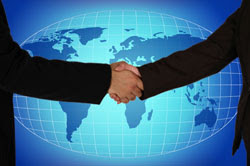sales promotion
Sales promotion is one of the seven aspects of the promotional mix. (The other six parts of the promotional mix are advertising, personal selling, direct marketing, publicity/public relations,corporate image and exhibitions.) Media and non-media marketing communication are employed for a pre-determined, limited time to increase consumer demand, stimulate market demand or improve product availability. Examples include contests, coupons, freebies, loss leaders, point of purchase displays, premiums, prizes, product samples, and rebates
Sales promotions can be directed at either the customer, sales staff, or distribution channel members (such as retailers). Sales promotions targeted at the consumer are called consumer sales promotions. Sales promotions targeted at retailers and wholesale are called trade sales promotions. Some sale promotions, particularly ones with unusual methods, are consideredgimmicks by many.
Sales promotion includes several communications activities that attempt to provide added value or incentives to consumers, wholesalers, retailers, or other organizational customers to stimulate immediate sales. These efforts can attempt to stimulate product interest, trial, or purchase. Examples of devices used in sales promotion include coupons, samples, premiums, point-of-purchase (POP) displays, contests, rebates, and sweepstakes.
Consumer sales promotion techniques
Price deal: A temporary reduction in the price, such as 50% off.
Loyal Reward Program: Consumers collect points, miles, or credits for purchases and redeem them for rewards.
Cents-off deal: Offers a brand at a lower price. Price reduction may be a percentage marked on the package.
Price-pack deal: The packaging offers a consumer a certain percentage more of the product for the same price (for example, 25 percent extra).
Coupons: coupons have become a standard mechanism for sales promotions.
Loss leader: the price of a popular product is temporarily reduced in order to stimulate other profitable sales
Free-standing insert (FSI): A coupon booklet is inserted into the local newspaper for delivery.
On-shelf couponing: Coupons are present at the shelf where the product is available.
Checkout dispensers: On checkout the customer is given a coupon based on products purchased.
On-line couponing: Coupons are available online. Consumers print them out and take them to the store.
Mobile couponing: Coupons are available on a mobile phone. Consumers show the offer on a mobile phone to a salesperson for redemption.
Online interactive promotion game: Consumers play an interactive game associated with the promoted product.
Rebates: Consumers are offered money back if the receipt and barcode are mailed to the producer.
Contests/sweepstakes/games: The consumer is automatically entered into the event by purchasing the product.
Point-of-sale displays:-
Aisle interrupter: A sign that juts into the aisle from the shelf.
Dangler: A sign that sways when a consumer walks by it.
Dump bin: A bin full of products dumped inside.
Glorifier: A small stage that elevates a product above other products.
Wobbler: A sign that jiggles.
Lipstick Board: A board on which messages are written in crayon.
Necker: A coupon placed on the 'neck' of a bottle.
YES unit: "your extra salesperson" is a pull-out fact sheet.
Electroluminescent: Solar-powered, animated light in motion.
Kids eat free specials: Offers a discount on the total dining bill by offering 1 free kids meal with each regular meal purchased.
Trade sales promotion techniques
Trade allowances: short term incentive offered to induce a retailer to stock up on a product.
Dealer loader: An incentive given to induce a retailer to purchase and display a product.
Trade contest: A contest to reward retailers that sell the most product.
Point-of-purchase displays: Used to create the urge of "impulse" buying and selling your product on the spot.
Training programs: dealer employees are trained in selling the product.
Push money: also known as "spliffs". An extra commission paid to retail employees to push products.
Trade discounts (also called functional discounts): These are payments to distribution channel members for performing some function .
Retail Mechanics
Retailers have a stock number of retail 'mechanics' that they regularly roll out or rotate for new marketing initiatives.
Buy x get y free a.k.a. BOGOF for Buy One Get One Free
Three for two
Buy a quantity for a lower price
Political issues
Sales promotions have traditionally been heavily regulated in many advanced industrial nations, with the notable exception of the United States. For example, the United Kingdom formerly operated under a resale price maintenance regime in which manufacturers could legally dictate the minimum resale price for virtually all goods; this practice was abolished in 1964.
Most European countries also have controls on the scheduling and permissible types of sales promotions, as they are regarded in those countries as bordering upon unfair business practices. Germany is notorious for having the most strict regulations. Famous examples include the car wash that was barred from giving free car washes to regular customers and a baker who could not give a free cloth bag to customers who bought more than 10 rolls.
ADVERTISING SALES PROMOTION
By using a variety of persuasive appeals, it offers reasons to buy a product or service.
Eg: Good Network, Promises and Delivers. Besides giving reasons in the form of different appeals, they offer incentive to the consumers to buy the product or service now.
For new users, 1HUTCH no is given free for 1 month & sms is free for 3 months.
Appeals are emotional or functional in nature.
Eg: the current ad of “Wherever you go, our network follows” Appeals are rational
It justifies whatever it says.
Time-frame is long term. Time frame is short term.
The primary objective is to create an enduring brand image. To get sales quickly or to induce trial.
Indirect and subtle approach towards persuading customers to buy a product or service. Direct in approach to induce consumers to buy a product or service immediately by temporarily changing the existing price-value relationship of the product or service.




Comments
Post a Comment